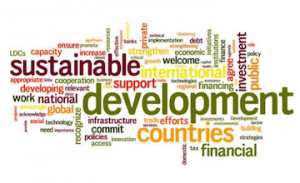Multilateral groups plan to extend more than $400b financing to meet SDGs
 As the world prepares to meet in Addis Ababa, Ethiopia from July 13 to 16, 2015 at the third Financing for Development Conference, the multilateral development banks and the IMF have shown intention to extend more than $400 billion to finance the Sustainable Development Goals (SDGs), a press release from the World Bank says.
As the world prepares to meet in Addis Ababa, Ethiopia from July 13 to 16, 2015 at the third Financing for Development Conference, the multilateral development banks and the IMF have shown intention to extend more than $400 billion to finance the Sustainable Development Goals (SDGs), a press release from the World Bank says.
The release indicates that the financing will be done over the next three years and they vowed to work more closely with private and public sector partners to help mobilize the resources needed to meet the historic SDGs.
The institutions are the African Development Bank (AfDB), Asian Development Bank (ADB), European Bank for Reconstruction and Development (EBRD), European Investment Bank (EIB), Inter-American Development Bank (IDB), World Bank Group (referred to as the MDBs), and the International Monetary Fund (IMF)—announced their plans in the lead-up to the Third International Conference on Financing for Development.
The release notes that the SDGs are ambitious and demand equal ambition in using the “billions” of dollars in current flows of official development assistance (ODA) and all available resources to attract, leverage and mobilize “trillions” in investments of all kinds—public and private, national and global.
ODA, estimated at $135 billion a year, provides a fundamental source of financing, especially in the poorest and most fragile countries. But more is needed. Investment needs in infrastructure alone reach up to $1.5 trillion a year in emerging and developing countries. Meeting the staggering but achievable needs of the SDG agenda requires everyone to make the best use of each dollar from every source, and draw in and increase public and private investment. The MDBs—the engines of development finance—are looking to a range of options for scaling up, it says.
According to Dr. Donald Kaberuka, President of the AfDB, “2015 is a critical year in charting the development future of Africa – the continent that still has the greatest development needs, and the continent that presents the greatest opportunity – for itself and for the world.”
“The level of collaboration among the MDBs in preparing the Financing for Development conference has been unprecedented, in coming up with innovative solutions to scale up development financing. One such is sovereign exposure exchange, where the African Development Bank is working closely with the World Bank and the Inter-American Development Bank to stretch our balance sheet so that we can scale up lending to our clients in North Africa,” he adds.
MDB development finance has grown from $50 billion in 2001 to $127 billion in 2015, the release says.
Stating their commitments to development, the release says, for each dollar invested by its shareholders, MDBs are able to commit $2-5 in new financing each year.
“The MDBs’ own direct private sector investments have increased fourfold over this period. They mobilize an additional $2-5 in private investment for every dollar they invest directly in private sector operations. The vow to increase their contribution to more than $400 billion over the next three years reflects in part efforts to make even better use of their balance sheets,” it says.
Commenting, Christine Lagarde, the Managing Director of the IMF says, “This year marks a once-in-a-generation opportunity for global development. The only way to seize it is through partnership. To go far, we must go together. The IMF—with its global membership and mandate to promote economic growth and stability—is a committed partner. In this pivotal year, we have targeted areas where providing additional support will have strong payoffs: we have just increased access to all our concessional loan facilities by a full 50 percent; we are set to expand our large program of support to developing countries in mobilizing domestic tax revenues; and we will deepen our policy engagement with countries on key development issues such as addressing infrastructure needs and promoting equity and inclusion.”
Additional steps to leverage more resources include the development of new approaches and tools to help developing countries play a stronger role in harnessing national resources. The MDBs and the IMF are partnering with countries on, for example, the introduction of a new toolkit to assess and improve tax policies and expanding instruments such as e-procurement to achieve better government spending.
The MDBs are also partnering with others to develop innovative financing approaches to support global needs, such as health and climate, building on extensive work already underway, the release adds.
By Emmanuel K. Dogbevi
